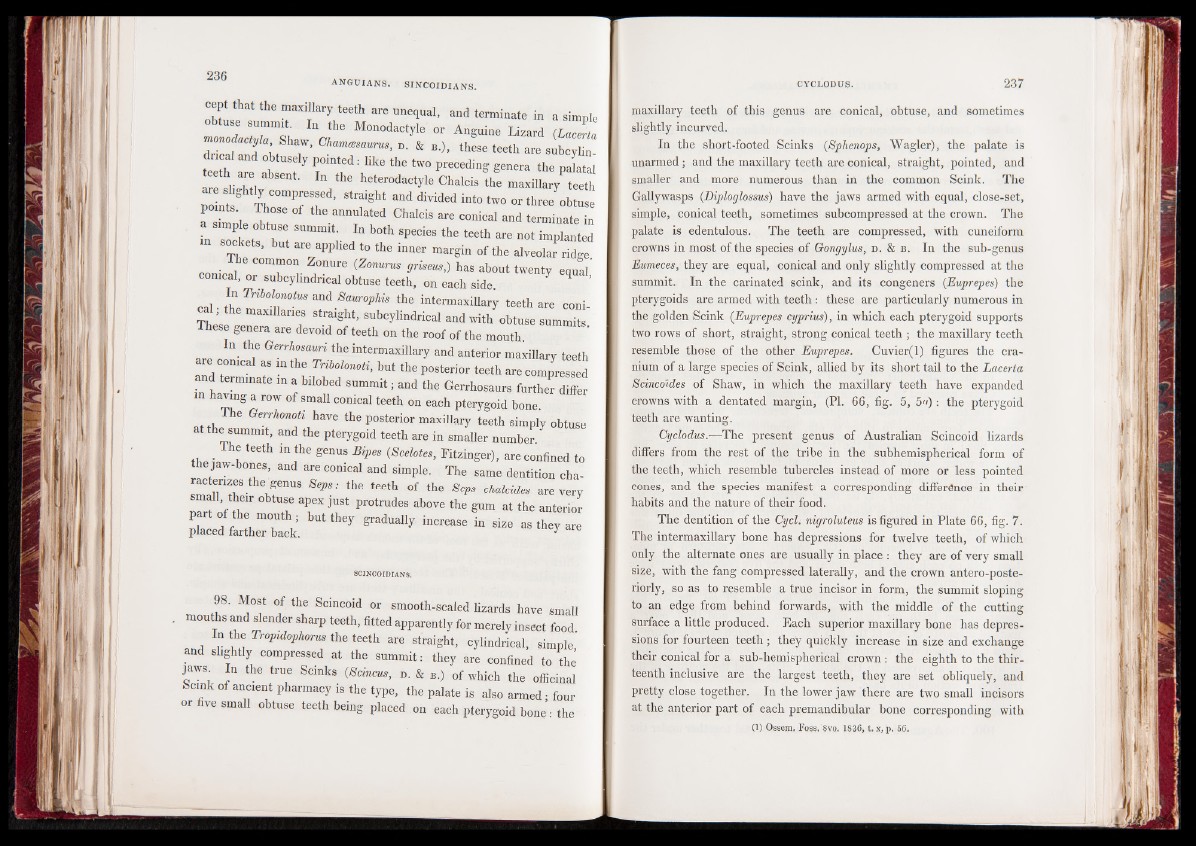
ept that the maxillary teeth are unequal, and terminate in a simple
obtuse summit. In ,he Monodactyle or Anguine Lizard (Lacml
« o n o ^ y la Shaw,C W s „™ , D. & B-), these teeth are | K
dncai and obtusely pointed: like the two preceding ra H fe* I M ge nmera thse pmaLal PZ ntts TThohser oTf thre an“nuTla6te d aCnhda ldciiVs iadreed cionn,°ic ta»l °a n“d terminoabtetu sine
a simple obtuse summit. In both species the teeth are not implanted
sockets, but are applied to the inner margin of the alveolar ridge
m common Zonure (Zonurus griseus,) has about twenty equal conical, or subcylmdrical obtuse teeth, on each side. 7 . 9 ’
n Tnhol™otus and Saurophis the intermaxillary teeth are coni
cal ; the maxdlanes straight, subcylindrical and with ohtuse summits’
These genera are devoid of teeth on the roof of the mouth
in the Gerrhosauri the intermaxillary and anterior maxillary teeth
are corneal as .„the BOMS b„, the posterior teeth are compressed
and terminate m a bdobed summitj and the Gerrhosaurs further differ
in haring a row of small conical teeth on each pterygoid bone.
The Gerrko m tihave the posterior maxillary teeth simply obtuse
atthesummit, and the pterygoid teeth are in smaller number.
ttbhPe j*a w-bp otn6eesth, ainnd! haer eg 6cnoUnSic Bali paenSd ( Sscimelpoltee.s > FTithzein gsaemr)e, adreen ctoitniofinn ecdh ato
racterizes the genus Sep.- the teeth of the Seps ehalcides are very
ppaarrtt ooff tthbeir mouTth ; TbuXt Jtfhey Pgr°ratrdUudaelSly f inlcre athsee giUn ms izaet tahse t»hteeyr iaorer placed farther back. y
98. Most of the Scmcoid or smooth-scaled Hzards have small
mouths and slender sharp teeth, fitted apparently for merely insect food.
n the Tropidophorus the teeth are straight, cylindrical, simple
and slightly compressed at the summit: they are confined to the
jaws In the true Scinks (Seme*, d. & b.) of which the officinal
Scmk of ancient pharmacy is the type, the palate is also armed • four
or five small obtuse teeth being placed on each pterygoid bone’: the
maxillary teeth of this genus are conical, obtuse, and sometimes
slightly incurved.
In the short-footed Scinks (Sphenops, Wagler), the palate is
unarmed; and the maxillary teeth are conical, straight, pointed, and
smaller and more numerous than in the common Scink. The
Gaily wasps (Diploglossus) have the jaws armed with equal, close-set,
simple, conical teeth, sometimes subcompressed at the crown. The
palate is edentulous. The teeth are compressed, with cuneiform
crowns in most of the species of Gongylus, d . & b . In the sub-genus
Eumeces, they are equal, conical and only slightly compressed at the
summit. In the carinated scink, and its congeners (Euprepes) the
pterygoids are armed with teeth : these are particularly numerous in
the golden Scink (Euprepes cyprius), in which each pterygoid supports
two rows of short, straight, strong conical teeth ; the maxillary teeth
resemble those of the other Euprepes. Cuvier(l) figures the cranium
of a large species of Scink, allied by its short tail to the Lacerta
Scinco'ides of Shaw, in which the maxillary teeth have expanded
crowns with a dentated margin, (PI. 66, fig. 5, 5'/) : the pterygoid
teeth are wanting.
CfycZodwsE-The present genus of Australian Scincoid lizards
differs from the rest of the tribe in the subhemispherical form of
the teeth, which resemble tubercles instead of more or less pointed
cones, and the species manifest a corresponding difference in their
habits and the nature of their food.
The dentition of the Cycl. nigroluteus is figured in Plate 66, fig. 7.
The intermaxillary bone has depressions for twelve teeth, of which
only the alternate ones are usually in place : they are of very small
size, with the fang compressed laterally, and the crown antero-poste-
riorly, so as to resemble a true incisor in form, the summit sloping
to an edge from behind forwards, with the middle of the cutting
surface a little produced. Each superior maxillary bone has depressions
for fourteen teeth ; they quickly increase in size and exchange
their conical for a sub-hemispherical crown : the eighth to the thirteenth
inclusive are the largest teeth, they are set obliquely, and
pretty close together. In the lower jaw there are two small incisors
at the anterior part of each premandibular bone corresponding with
(1) Ossem, Foss. 8vo. 1836, t. x, p. 56.